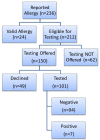Improving routine prenatal penicillin allergy testing for reported penicillin allergy
- PMID: 35906008
- PMCID: PMC9345039
- DOI: 10.1136/bmjoq-2022-001859
Improving routine prenatal penicillin allergy testing for reported penicillin allergy
Abstract
Background: Patients with self-reported antibiotic allergies have a higher cost of care, more frequent infections with resistant bacteria and worse health outcomes than patients without antibiotic allergies. Ultimately, less than 5% of patients who report a penicillin allergy have a clinically significant immune-mediated hypersensitivity reaction when tested. As 10%-30% of the population of pregnant patients are colonised for group B Streptococcus (GBS) and guidelines recommend penicillin as the treatment of choice for GBS, current recommendations support penicillin allergy testing in pregnant patients who report an allergy.
Methods and intervention: In this quality improvement project, nursing staff used an algorithm outlining inclusion and exclusion criteria to determine which patients were eligible to have penicillin allergy testing completed. Penicillin allergy testing consisted of a skin test using benzylpenicilloyl polylysine (Pre-Pen), penicillin G potassium, amoxicillin and alkaline hydrolysis mix (penicilloate) as a prick skin test, followed by intradermal skin test and finally an oral challenge with either amoxicillin or penicillin. Patient outcomes were analysed to evaluate the impact of the intervention.
Results: Of the 1266 patients receiving prenatal care during the intervention, 236 (19%) reported a history of penicillin allergy, and 212 if these were eligible for testing. 150 of the eligible patients were offered penicillin allergy testing. 101 patients (67%) completed testing and 49 (33%) declined testing. Seven patients (7%) had positive penicillin allergy testing, while 94 patients (93%) had negative penicillin allergy testing and were immediately de-labelled as penicillin allergic. Seventeen of the de-labelled patients subsequently tested positive for GBS colonisation, and all received intrapartum penicillin without adverse events.
Conclusions: Pursuing penicillin allergy testing for pregnant patients with reported penicillin allergy is a safe and feasible approach, allowing for allergy de-labelling and safe, guideline-driven antimicrobial therapy during subsequent labour and delivery hospitalisations. Cost-effectiveness of the allergy testing and impact on later episodes of care should be further investigated.
Keywords: antibiotic management; healthcare quality improvement; obstetrics and gynecology; primary care; quality improvement.
© Author(s) (or their employer(s)) 2022. Re-use permitted under CC BY-NC. No commercial re-use. See rights and permissions. Published by BMJ.
Conflict of interest statement
Competing interests: RT has research funding and know-how agreements with HeraMed, unrelated to this project.
Figures
Similar articles
-
Diagnosis and clinical management of drug allergies in obstetrics and gynecology: an expert review.Am J Obstet Gynecol. 2025 Mar;232(3):243-261. doi: 10.1016/j.ajog.2024.10.025. Epub 2024 Oct 28. Am J Obstet Gynecol. 2025. PMID: 39490659 Review.
-
Oral amoxicillin challenge for low-risk penicillin allergic patients.Intern Med J. 2022 Feb;52(2):295-300. doi: 10.1111/imj.14978. Epub 2022 Jan 12. Intern Med J. 2022. PMID: 32672891
-
De-labelling self-reported penicillin allergy within the emergency department through the use of skin tests and oral drug provocation testing.Emerg Med Australas. 2017 Oct;29(5):509-515. doi: 10.1111/1742-6723.12774. Epub 2017 Apr 5. Emerg Med Australas. 2017. PMID: 28378949
-
Skin testing and oral amoxicillin challenge in the outpatient allergy and clinical immunology clinic in pregnant women with penicillin allergy.Ann Allergy Asthma Immunol. 2020 Dec;125(6):646-651. doi: 10.1016/j.anai.2020.08.012. Epub 2020 Aug 13. Ann Allergy Asthma Immunol. 2020. PMID: 32798617
-
Evaluation and Management of Penicillin Allergy: A Review.JAMA. 2019 Jan 15;321(2):188-199. doi: 10.1001/jama.2018.19283. JAMA. 2019. PMID: 30644987 Review.
Cited by
-
β-Lactam allergy delabeling is safe and saves costs in Primary Care.Aten Primaria. 2024 Nov;56(11):102925. doi: 10.1016/j.aprim.2024.102925. Epub 2024 May 24. Aten Primaria. 2024. PMID: 38795675 Free PMC article.
-
Antepartum vs postpartum amoxicillin oral challenge in pregnant patients with a reported penicillin allergy: A two-center prospective cohort study.Acta Obstet Gynecol Scand. 2024 Nov;103(11):2289-2295. doi: 10.1111/aogs.14964. Epub 2024 Sep 10. Acta Obstet Gynecol Scand. 2024. PMID: 39254054 Free PMC article.
-
Perceived usefulness of a mnemonic to improve nurses' evaluation of reported penicillin allergies.Antimicrob Steward Healthc Epidemiol. 2023 Jul 11;3(1):e124. doi: 10.1017/ash.2023.177. eCollection 2023. Antimicrob Steward Healthc Epidemiol. 2023. PMID: 37502243 Free PMC article.
-
Penicillin allergy delabeling: Opportunities for implementation and dissemination.Ann Allergy Asthma Immunol. 2023 May;130(5):554-564. doi: 10.1016/j.anai.2022.12.023. Epub 2022 Dec 20. Ann Allergy Asthma Immunol. 2023. PMID: 36563744 Free PMC article. Review.
References
-
- Joint Task force on practice P, American Academy of allergy a, immunology, et al. drug allergy: an updated practice parameter. Ann Allergy Asthma Immunol 2010;105:259–73. - PubMed
Publication types
MeSH terms
Substances
LinkOut - more resources
Full Text Sources
Medical
Research Materials


